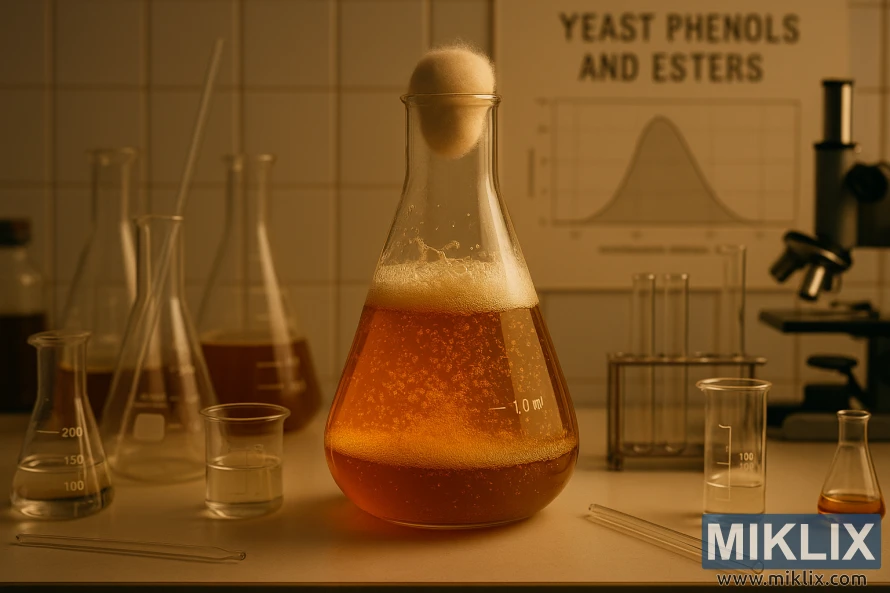Image: Fermenting Belgian Ale in Laboratory
Published: September 24, 2025 at 3:32:15 PM UTC
A warm, detailed laboratory scene with glassware and a bubbling golden Belgian ale flask, symbolizing precision and brewing craftsmanship.
The image depicts a beautifully composed laboratory scene bathed in soft, warm lighting that gives the space an inviting yet meticulously technical atmosphere. The setting is presented in landscape orientation, allowing the eye to wander across an orderly workbench filled with various pieces of glassware and scientific equipment, each arranged to suggest both active experimentation and careful precision. The central focus is a large Erlenmeyer flask filled with a vibrant, golden-amber liquid representing an actively fermenting Belgian ale. This flask stands prominently at the front of the composition, its gently rounded body catching the warm light and radiating a rich, luminous glow that contrasts against the softer, more neutral tones of the surrounding environment.
Inside the flask, the ale is alive with activity. Countless tiny bubbles rise continuously from the bottom to the surface, creating delicate swirls and eddies that capture the motion of fermentation in progress. A frothy cap of foam crowns the liquid, clinging just below the flask’s narrow neck, evidence of the vigorous metabolic activity of the yeast. The glass is slightly dewy from condensation, and the warm backlighting enhances the golden hues, making the ale appear to glow from within. A cotton stopper gently plugs the flask’s opening, lending a touch of authenticity and hinting at controlled conditions meant to protect the fermenting contents from contamination while still allowing gas exchange.
Surrounding the central vessel is an array of laboratory glassware that reinforces the sense of analytical precision. Several tall, slender Erlenmeyer flasks and graduated cylinders stand in the background, some containing clear liquid and others filled with varying shades of amber fluid, possibly different wort samples or yeast starters. Their clean, angular silhouettes are softly blurred by the shallow depth of field, ensuring they complement rather than compete with the primary fermentation vessel. In the foreground, smaller beakers and measuring cylinders contain transparent and faintly tinted liquids, while glass pipettes rest on the benchtop, suggesting recent use. The arrangement of these tools conveys a sense of active experimentation, as if measurements, transfers, and analyses are all part of the ongoing effort to fine-tune the fermentation profile.
To the right, a sturdy laboratory microscope stands partially in shadow, its form recognizable yet subtle, reinforcing the scientific rigor underpinning the craft of brewing without distracting from the main focus. Nearby, a test tube rack holds several clean, empty tubes, their polished glass catching soft highlights from the surrounding light. On the tiled wall behind the workbench, a poster is visible bearing the heading “YEAST PHENOLS AND ESTERS,” accompanied by a smooth bell-shaped graph. This element adds an explicit conceptual layer to the image, linking the scene to the biochemical artistry at work: the careful balancing of phenolic and ester compounds that give Belgian ales their signature spicy, fruity character.
The overall lighting is warm, golden, and diffuse, with no harsh shadows. It pools gently across the benchtop and glass surfaces, highlighting the contours of the vessels and the fine effervescence within the fermenting ale. This lighting creates a mood that is both technical and inviting, harmonizing the worlds of science and craft. The warm glow of the fermenting liquid contrasts beautifully against the clean, controlled backdrop of the lab, emphasizing the delicate art of coaxing flavor through controlled biochemical processes.
In sum, the image embodies the fusion of analytical precision and creative craftsmanship at the heart of brewing. The composition celebrates the complexity and nuance of yeast’s contribution to Belgian-style ale, framing fermentation not as a chaotic biological process but as an orchestrated act of artistry, guided by data, experimentation, and the patient hand of a dedicated brewer-scientist.
The image is related to: Fermenting Beer with Mangrove Jack's M41 Belgian Ale Yeast

